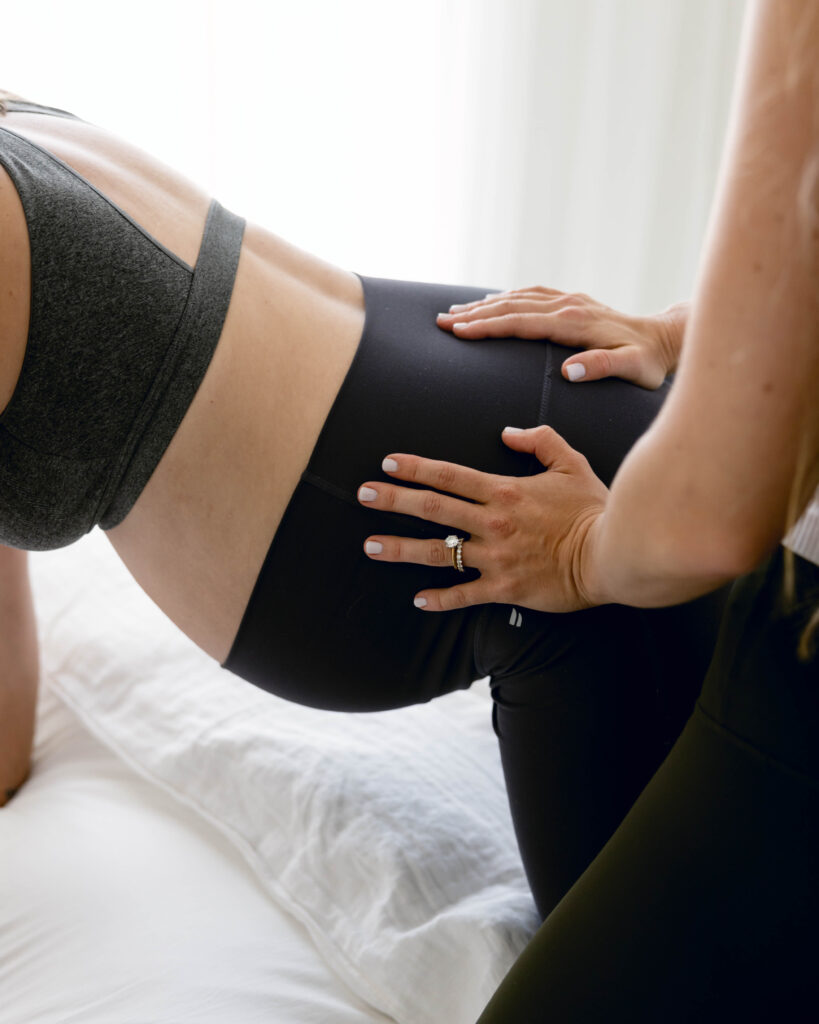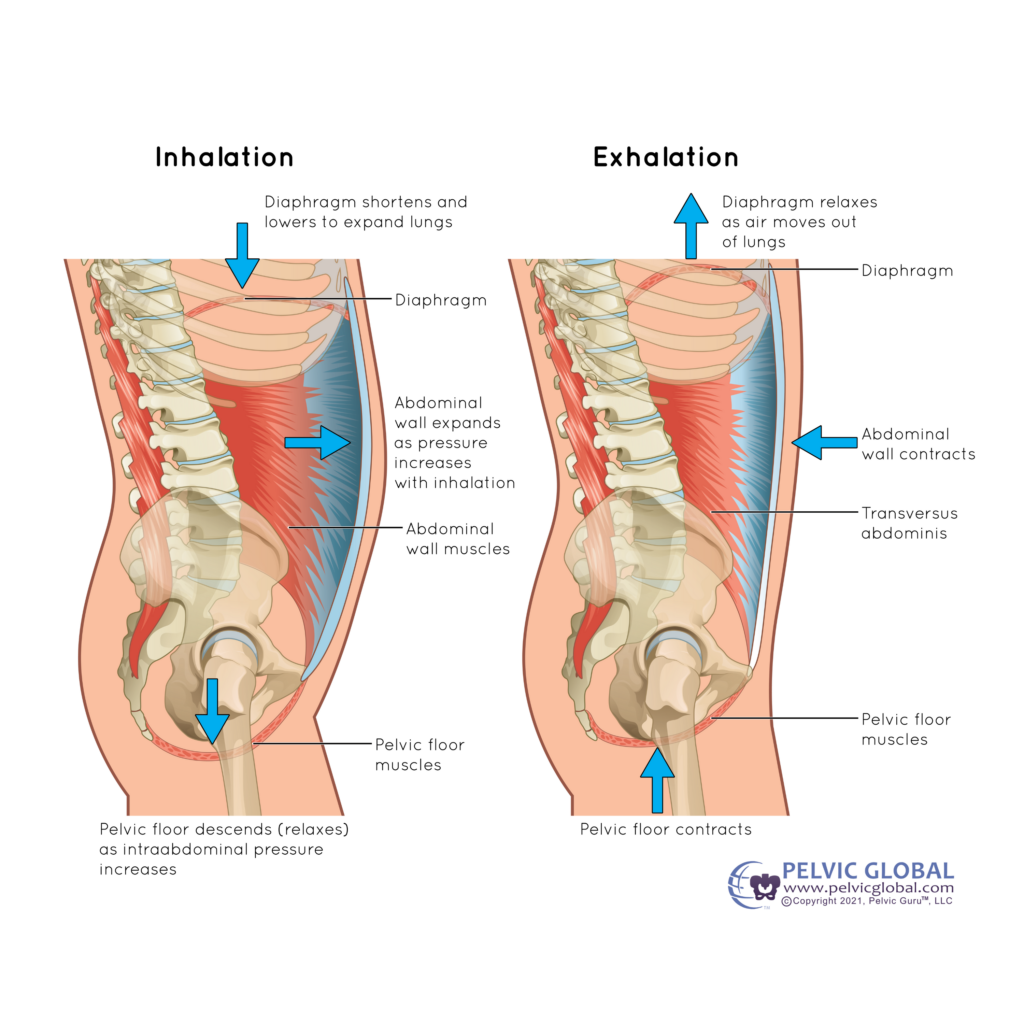Why You Need to Relax Your Pelvic Floor During Birth (and How to Do It)

Here’s the thing: birth is a major physical event. Women are amazing in so many ways, and delivering a new life into the world is just one of them! The heart of a mama is strong — and I spend a ton of my time as a pelvic floor PT helping pregnant women find that same strength in their bodies as they move through pregnancy and prepare for labor and delivery.
There are lots of myths out there about pregnancy workouts and labor preparation. But I’m here to simplify things! I want to help you learn how to do the workouts you love during and after pregnancy, prepare your body for motherhood and postpartum, and find relief for pelvic floor tightness or weakness, and so much more.
I’m all about building strength, but when you’re in a birthing suite, you actually don’t need a tighter, tensed-up pelvic floor. Instead, you’ll need to learn how to relax it as you give birth. Sounds counterintuitive? I get it! But I’m here to break it all down.
The myth about your pelvic floor in childbirth
It’s a common misconception that your pelvic floor strains and pushes until baby arrives in the world! In fact, it’s so common that you may have even been told to kegel in preparation for birth to get your pelvic floor strong. I can understand where this mistaken line of thinking comes from! But in reality, pelvic floor relaxation is the key to reducing risk for perineal tears and other physical trauma from childbirth.
Don’t get me wrong, a strong and coordinated pelvic floor is still important for core stability, especially when you’re supporting the growing weight of your baby and uterus! But just like any other muscle in the body — you want to be able to contract AND relax your pelvic floor muscles efficiently and effectively.
Let’s think about this from an anatomical point of view. Your pelvic floor wraps around three openings — your urethra, where urine is expelled, your anal sphincter, where bowel movements take place, and your vaginal opening, which is where all the childbirth magic happens.
When your pelvic floor contracts, these openings all get smaller. This is why we contract our pelvic floor when we’re wandering around a grocery store looking for the bathroom — it literally holds things in for us! This is a functionality we need, of course, but we don’t want to hold baby in during labor and delivery!
Instead, you should train your pelvic floor muscles to relax and lengthen during childbirth. It helps your vaginal opening… well, open. Your pelvic floor should be able to stretch and part —this is what will allow your baby to be birthed vaginally.
Breathwork: the key to pelvic floor relaxation
If you’re getting close to your due date, you’re probably already incorporating daily movements to prepare your body for labor. This is the perfect time to add in some simple breathwork! Breathing with purpose will help you relax and lengthen your pelvic floor, so that when it’s time to deliver, you’ll be able to do it without overthinking.
First, understand that your pelvic floor and your diaphragm work in tandem. Your pelvic floor lengthens on an inhale as your diaphragm lengthens and lowers, just like an internal piston system. To activate this, wrap your hands around your ribcage and think of actively expanding your ribs 360 degrees. Feel your chest, belly and ribs all expand — and take special note of the way you direct some of that air down into your pelvic floor.

Image used with permission from Pelvic Guru®, LLC as a member of the Global Pelvic Health Alliance Membership (GPHAM)
If you’re struggling to “feel” the length of your pelvic floor as you inhale, try getting into child’s pose! This is my favorite exercise to emphasize breathing into my lower back and posterior pelvic floor (which are both areas that are commonly tight in pregnant women). Instead of inhaling “up” into your ribs and throat, think of inhaling “down” into your lower back and anal sphincter, feeling them expand as you breathe in.
P.S. This video is taken directly from my Movement Through Early Postpartum program where every exercise has both audio and written cues to ensure your success!
Releasing tension from your lower back and hips
Pelvic floor tension is not generated solely from the pelvic floor muscles themselves! Tightness can actually stem from tension in nearby muscles, which influences the position of the pelvis and can keep the pelvic floor muscles stretched taut instead of allowing them to relax.
The two biggest culprits for posterior pelvic floor tension? Tight glutes and deep hip rotators! If you’re constantly clenching your butt cheeks or tucking your tailbone, you will experience posterior pelvic floor tightness. It’s common for pregnant women to clench or tuck to compensate for the added weight in your belly as the baby grows, so be mindful of your posture!
To ensure full mobility in your hips, relaxation in your glutes, and balanced tension throughout your pelvis, add simple exercises into your daily movements. My favorite trio:
1. Glute Rock Backs
2. Adductor Rock Backs
3. Knee to Chest Circles
Pushing positions that actually allow your pelvic floor to relax
Pushing positions definitely matter when it comes to pelvic floor relaxation! Whether you’re trying to maintain mobility throughout your third trimester or you’re in full-on delivery prep mode, a birth ball is a great thing to have by your side. Try these positions with it to increase mobility and prepare for the big day!
When it comes to actual delivery, these are the positions I recommend most to my patients to lengthen the pelvic floor. Switch up between these and the birth ball positions — do whatever is right and best for your body as you labor!
Side-lying
Side-lying is actually one of the few positions with evidence that proves a decreased risk of severe perineal tearing. If that’s not a good enough reason to try it, I don’t know what is! Keeping your sacrum unrestricted is most likely a factor in this, since your sacrum and tailbone need to move to allow the pelvic floor to better expand during birth. When you’re flat on your back, your sacrum is blocked by the bed below you, so it has much less room. In this position, though, it can move freely!
Quadruped
In the quadruped position (which you can do with or without a birth ball!), you also get the freedom of sacrum movement. Another advantage here: you can easily get your feet wider than your knees, relaxing and expanding your entire lower body. This position also helps you avoid the temptation of bringing the knees in close to the chest, which can actually increase pelvic floor tension.
A note for birthing on your back
I’m not totally against birthing on your back — but there are a few very important caveats that can help you lengthen your pelvic floor and reduce your tearing risk.
First, try to be in a semi-recumbent position, which means the head of the bed is elevated. Lying flat does not help your pelvic floor!
Secondly, opt to leave your feet out of stirrups. Instead, bring your knees closer to one another and relax your feet relaxed, keeping them slightly wider than your knees. There’s no need to bring the knees in tight against the chest, as this might increase tension in the pelvic floor, making it harder to relax and stretch when you need it most.
Preparing your pelvic floor for birth
Want to feel empowered and prepared as you head into your baby’s birth? I want that for you, too! That’s why I created Movement Through Labor and Delivery, a labor prep course developed by me (a Doctor of Physical Therapy who specializes in pelvic floor) and a Certified Nurse Midwife (who happens to be a fantastic friend and resource). Together, we’ll teach you how to lengthen and relax your pelvic floor, of course — but there’s so much more.
Movement Through Labor and Delivery will help you:
- Get your entire body ready for childbirth and recovery
- Know how to advocate for yourself and make informed decisions
- Breathe and move through the stages of labor
- Enhance your birth experience and minimize tearing
- Learn more about labor positions and find what works for you
- Optimize your baby’s position for delivery
- Prepare for an enhanced vaginal or cesarean delivery
- Provide your support person with hands-on techniques
Through 12 educational modules, specific movement flows to help you prepare, and cheat sheets to bring along to labor and delivery, you’ll be ready and confident — and that’s what matters most.